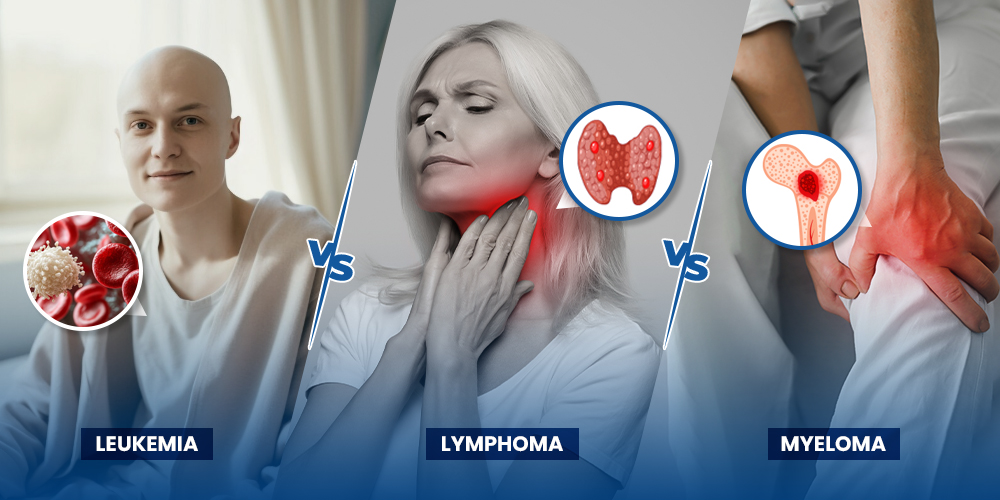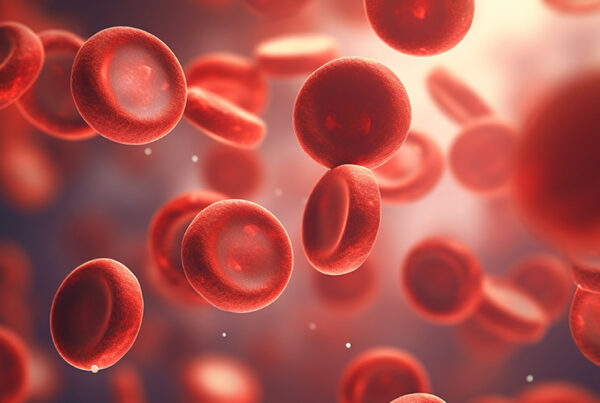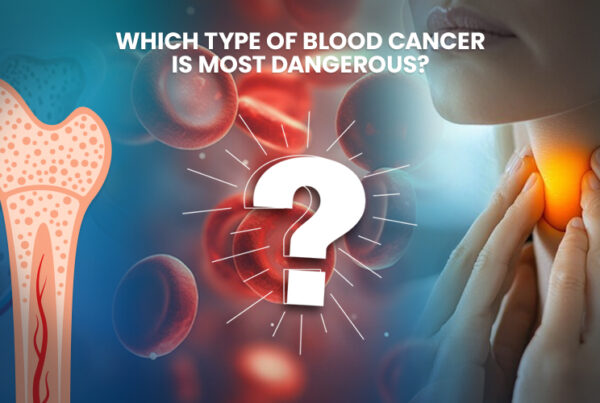
Most cancers are solid. Breast, lung, or kidney tumors grow into solid masses. But blood cancers? They’re different.
These cancers, known as hematologic malignancies, form in the blood, bone marrow, and lymphatic system: parts of your body that are always in motion. Because of that, blood cancers don’t form solid tumors. Instead, they disrupt your body’s blood-making and immune systems from the inside. Each of the three main types- leukemia, lymphoma, and myeloma, start in a different part of this fluid system.
While they may share similar symptoms, they behave very differently and require different treatment strategies.
Blood Cancer
Understanding what is blood cancer starts with recognizing how different it is from other cancers. This cancer doesn’t sit still; it moves through your body disrupting your internal systems. Especially targeting the cells that your body relies on daily for oxygen, nutrition, and immune defense. That’s why early diagnosis and identifying the exact type is so important.
What Is Leukemia?
Leukemia is a cancer of the blood and bone marrow. It occurs when abnormal white blood cells grow uncontrollably, crowding out healthy blood cells.
There are different types of leukemia, depending on how fast it progresses (acute or chronic) and which white blood cell type it affects (lymphoid or myeloid).
Major Types of Leukemia:
- Acute lymphocytic leukemia (ALL) – mostly affects children.
- Acute myeloid leukemia (AML) – common in older adults.
- Chronic lymphocytic leukemia (CLL) – slow-growing, mostly in adults.
- Chronic myeloid leukemia (CML) – often has a specific genetic mutation (Philadelphia chromosome).
Quick Facts:
- Starts in the bone marrow.
- Impacts white blood cell production.
- Symptoms: fatigue, frequent infections, bruising, weight loss.
What Is Lymphoma?
Lymphoma starts in the lymphatic system—the network of lymph nodes, spleen, and immune tissues that help fight infections.
It develops when lymphocytes (a type of white blood cell) grow and multiply uncontrollably.
Main Types of Lymphoma:
The classification of lymphoma begins with Hodgkin vs Non-Hodgkin Lymphoma.
- Hodgkin lymphoma (HL) – marked by the presence of Reed-Sternberg cells.
- Non-Hodgkin lymphoma (NHL) – a broad category with over 60 subtypes, including diffuse large B-cell lymphoma, small lymphocytic lymphoma, MALT lymphoma and follicular lymphoma.
Quick Facts:
- Starts in lymph nodes or lymph tissue.
- Can spread to bone marrow and organs.
- Symptoms: swollen lymph nodes, night sweats, unexplained fever, fatigue.
What Is Multiple Myeloma?
Myeloma, also known as multiple myeloma, begins in plasma cells: a type of white blood cell in the bone marrow that produces antibodies.
When plasma cells become cancerous, they build up in the bone marrow and interfere with the production of healthy blood cells and antibodies.
Quick Facts:
- Starts in plasma cells in the bone marrow.
- Weakens bones and suppresses immunity.
- Symptoms: bone pain (especially in the back or ribs), frequent infections, fatigue, kidney problems.
Is Multiple Myeloma Hereditary?
Multiple myeloma is not typically considered a hereditary cancer, having a close relative with the disease can slightly increase your risk. Studies suggest that shared genetic traits and environmental exposures in families may contribute to this increased risk.
However, most people diagnosed with multiple myeloma do not have a family history of it. Genetic screening is not routinely recommended unless there are multiple blood cancers in the family.
Key Differences Between Leukemia, Lymphoma, and Myeloma
| Feature | Leukemia | Lymphoma | Myeloma |
|---|---|---|---|
| Origin | Bone marrow & blood | Lymphatic system | Plasma cells in bone marrow |
| Cell Type Affected | White blood cells | Lymphocytes | Plasma cells |
| Tumor Formation | No solid tumor | Can cause swollen lymph nodes | Often no tumor, affects bones |
| Symptoms | Fatigue, bruising, infections | Swollen nodes, fever, weight loss | Bone pain, fatigue, infections |
| Common Age Group | Children & older adults | Teens (HL) and older adults (NHL) | Mostly older adults |
| Treatment | Chemo, targeted therapy, bone marrow transplant | Chemo, radiation, immunotherapy | Chemo, targeted therapy, stem cell transplant |
Which Type of Blood Cancer Is Most Dangerous?
It depends on the subtype and how early it’s caught.
- Acute Myeloid Leukemia (AML) is considered one of the most aggressive blood cancers, especially in older adults. It progresses quickly and often requires immediate, intensive treatment.
- Multiple Myeloma is serious and currently incurable, though treatments can manage symptoms and extend life.
- Certain subtypes of Non-Hodgkin Lymphoma, like diffuse large B-cell lymphoma (DLBCL), are aggressive but can be cured if treated early.
Survival Rates (5-Year Average in the U.S.):
In the United States, the overall 5-year survival rate for blood cancers is about 67%. However, survival rates vary significantly depending on the specific type of disease, such as:
| Type | 5-Year Survival Rate |
|---|---|
| Acute Lymphocytic Leukemia | ~71% |
| Acute Myeloid Leukemia | ~32% |
| Chronic Lymphocytic Leukemia | ~88% |
| Hodgkin Lymphoma | ~89% |
| Non-Hodgkin Lymphoma | ~74% |
| Multiple Myeloma | ~60% |
Can One Blood Cancer Lead to Another?
Yes, in rare cases. Treatments like chemotherapy or radiation for one blood cancer can increase the risk of developing a second blood cancer later in life. For example:
- Radiation therapy may increase the risk of leukemia or myelodysplastic syndromes (MDS).
- Some chemotherapy drugs can damage DNA in healthy cells, leading to secondary cancers.
It’s rare, but something oncologists observe closely in long-term cancer survivors.
Common Symptoms of Blood Cancers
While each type has unique symptoms, some warning signs overlap:
- Fatigue and weakness
- Frequent infections
- Easy bruising or bleeding
- Swollen lymph nodes
- Bone pain
- Unexplained weight loss
- Night sweats or fever
If these symptoms persist, especially in combination, it’s important to consult a healthcare provider.
What Causes Blood Cancers?
There’s no single cause, but certain factors raise your risk:
- Age
- Genetic mutations
- Radiation or chemical exposure
- Weakened immune system
- Cancer history
How Is Leukemia Diagnosed?
Diagnosing leukemia involves several tests:
- Blood tests – A complete blood count (CBC) often reveals abnormal white blood cell levels.
- Bone marrow biopsy – Confirms the presence of leukemia cells and helps identify the subtype.
- Genetic testing – Detects specific mutations like the Philadelphia chromosome leukemia, which guides treatment.
- Imaging – In some cases, scans like CT or PET are used to assess organ involvement.
Accurate diagnosis helps doctors create the most effective treatment plan tailored to the specific type and stage of leukemia.
Final Thoughts
Leukemia, lymphoma, and multiple myeloma each come with their own challenges. Understanding how they differ can take away some of the confusion and help you feel a little more grounded.
If you’re weighing treatment options, it might be worth looking into clinical trials for oncology. They can offer access to promising therapies still in testing.
And if you’re in the Midwest, don’t overlook paid research studies in Nebraska: a lesser-known way to get involved in cutting-edge care while getting support.
In the end, the more you know, the more confident you’ll feel in making choices that work for you or someone you care about.







